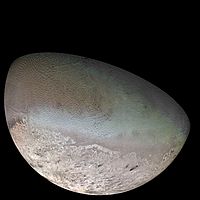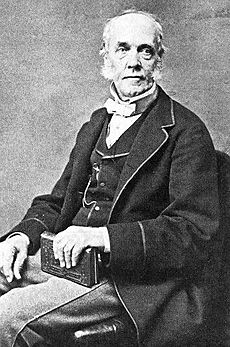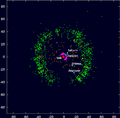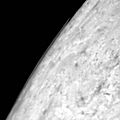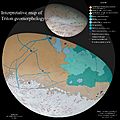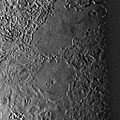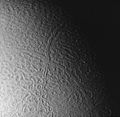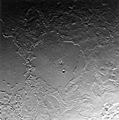Triton (moon) facts for kids
Triton, or Neptune I, is the largest moon of the planet Neptune. It is the seventh-largest moon in the Solar System. Triton is slightly smaller than Earth's Moon. Triton has a complicated geological history, and it is thought to have a comparatively young surface compared to the age of the Solar System itself.
Triton is the coldest-known body in the Solar System. The surface temperature of Triton was recorded by Voyager 2 as -235 °C (-391 °F). Triton has its own magnetic field and has a faint trace of an atmosphere.
Neptune Odyssey is a mission concept for a Neptune orbiter with a focus on Triton being studied as a possible large strategic science mission by NASA that would launch in 2033 and arrive at the Neptune system in 2049.
Discovery and naming
Triton was discovered by British astronomer William Lassell on October 10, 1846, just 17 days after the discovery of Neptune. When John Herschel received news of Neptune's discovery, he wrote to Lassell suggesting he search for possible moons. Lassell discovered Triton eight days later. Lassell also claimed for a period to have discovered rings. Although Neptune was later confirmed to have rings, they are so faint and dark that it is not plausible he saw them. A brewer by trade, Lassell spotted Triton with his self-built 61 cm (24 in) aperture metal mirror reflecting telescope (also known as the "two-foot" reflector). This telescope was donated to the Royal Observatory, Greenwich in the 1880s, but was eventually dismantled.
Triton is named after the Greek sea god Triton (Τρίτων), the son of Poseidon (the Greek god corresponding to the Roman Neptune). The name was first proposed by Camille Flammarion in his 1880 book Astronomie Populaire, and was officially adopted many decades later. Until the discovery of the second moon Nereid in 1949, Triton was commonly referred to as "the satellite of Neptune". Lassell did not name his discovery; he later successfully suggested the name Hyperion, previously chosen by John Herschel, for the eighth moon of Saturn when he discovered it.
Orbit and rotation
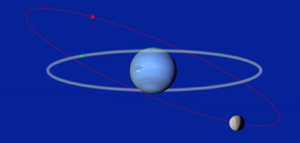
Triton is unique among all large moons in the Solar System for its retrograde orbit around its planet (i.e. it orbits in a direction opposite to the planet's rotation). Most of the outer irregular moons of Jupiter and Saturn also have retrograde orbits, as do some of Uranus's outer moons. However, these moons are all much more distant from their primaries, and are small in comparison; the largest of them (Phoebe) has only 8% of the diameter (and 0.03% of the mass) of Triton.
Triton's orbit is associated with two tilts, the obliquity of Neptune's rotation to Neptune's orbit, 30°, and the inclination of Triton's orbit to Neptune's rotation, 157° (an inclination over 90° indicates retrograde motion). Triton's orbit precesses forward relative to Neptune's rotation with a period of about 678 Earth years (4.1 Neptunian years), making its Neptune-orbit-relative inclination vary between 127° and 173°. That inclination is currently 130°; Triton's orbit is now near its maximum departure from coplanarity with Neptune's.
Triton's rotation is tidally locked to be synchronous with its orbit around Neptune: it keeps one face oriented toward the planet at all times. Its equator is almost exactly aligned with its orbital plane. At present, Triton's rotational axis is about 40° from Neptune's orbital plane, and hence as Neptune orbits the Sun, Triton's polar regions take turns facing the Sun, resulting in seasonal changes as one pole, then the other moves into the sunlight. Such changes were observed in 2010.
Triton's revolution around Neptune has become a nearly perfect circle with an eccentricity of almost zero. Viscoelastic damping from tides alone is not thought to be capable of circularizing Triton's orbit in the time since the origin of the system, and gas drag from a prograde debris disc is likely to have played a substantial role. Tidal interactions also cause Triton's orbit, which is already closer to Neptune than the Moon is to Earth, to gradually decay further; predictions are that 3.6 billion years from now, Triton will pass within Neptune's Roche limit. This will result in either a collision with Neptune's atmosphere or the breakup of Triton, forming a new ring system similar to that found around Saturn.
Orbit
Drag and tidal interaction cause Triton to fall slowly into lowered orbits. This process is immensely slow. 3.6 billion years from now, Triton will pass within Neptune's Roche limit. It will either collide with Neptune's atmosphere or break up, forming a ring system similar to that found around the planet Saturn.
The reason why Triton is thought to be a captured object is its orbit, which is unique in the Solar System. It is both retrograde (see diagram) and highly tilted. Although there are other satellites with retrograde orbits, they are much smaller than Titan, and much more distant from their host planets (their "primaries"). Triton, like our Moon, shows only one face to the planet: it rotates in synchrony to Neptune.
Surface
All we know about the surface of Triton comes from one fly-by of Voyager 2 in 1989. There are few impact craters. This suggests the surface is quite young in astronomical terms: estimates are six to 50 million years.
Despite its very cold temperature, the surface of Triton is geologically active. There are events which look like geysers, volcanos and earthquakes. All the materials involved are quite different from those on Earth. Most of the gases are frozen most of the time. Gases like nitrogen are frozen until something occurs to melt them, then it turns back into a gas. A temperature increase of just 4 K (7.2 °F) is enough to make this happen. The surface shows deposits of tholins, organic chemical compounds that may be precursors to the origin of life.
Images for kids
-
The Kuiper belt (green), in the Solar System's outskirts, is where Triton is thought to have originated.
-
The orbit of Triton (red) is different from most moons' orbit (green) in the movement's direction, and the orbit is tilted.
-
Interpretative geomorphological map of Triton
-
Close up of the volcanic province of Leviathan Patera, the caldera in the center of the image. Several pit chains extend radially from the caldera to the right of the image, while the smaller of the two cryolava lakes is seen to the upper left. Just off-screen to the lower left is a fault zone aligned radially with the caldera, indicating a close connection between the tectonics and volcanology of this geologic unit.
-
Two large cryolava lakes on Triton, seen west of Leviathan Patera. Combined, they are nearly the size of Kraken Mare on Titan. These features are unusually crater free, indicating they are young and were recently molten.
-
Tuonela Planitia (left) and Ruach Planitia (center) are two of Triton's cryovolcanic "walled plains". The paucity of craters is evidence of extensive, relatively recent, geologic activity.
See also
 In Spanish: Tritón (satélite) para niños
In Spanish: Tritón (satélite) para niños


